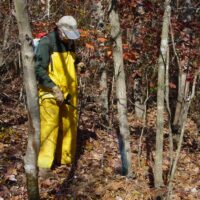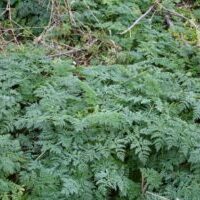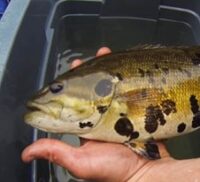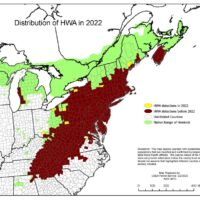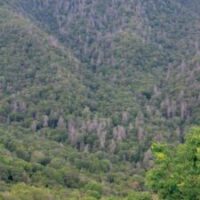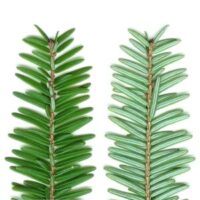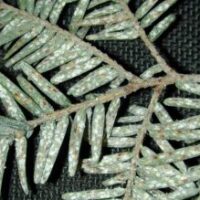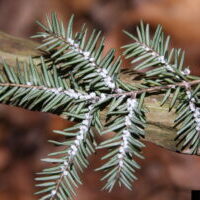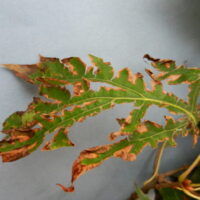 Purdue University - Extension - Forestry and Natural Resources
Purdue University - Extension - Forestry and Natural Resources
Got Nature? Blog
Purdue Landscape Report: Despite the sublime name, tree-of-heaven, Ailanthus altissima, is a particularly bad actor when it comes to trees encountered in the Midwest. This native of Asia was introduced to North America more than 150 years ago and has since become a widespread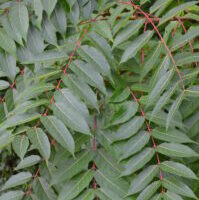 invasive pest. Rapid growth, extremely high seed production (hundreds of thousands from a mature female tree), and root sprouting that can turn one tree into dozens makes this a formidable competitor with our native plants. Tree-of-Heaven can sprout and grow almost anywhere, including cracks in streets and sidewalks or building foundations, resulting in infrastructure damage and increased costs of maintenance. It is also the preferred host for a new and destructive invasive insect pest, the spotted lantern fly.
invasive pest. Rapid growth, extremely high seed production (hundreds of thousands from a mature female tree), and root sprouting that can turn one tree into dozens makes this a formidable competitor with our native plants. Tree-of-Heaven can sprout and grow almost anywhere, including cracks in streets and sidewalks or building foundations, resulting in infrastructure damage and increased costs of maintenance. It is also the preferred host for a new and destructive invasive insect pest, the spotted lantern fly.
Reducing tree-of-heaven numbers on the landscape is a worthy goal, but can be a difficult task. Seed is windblown and can disperse for hundreds of yards or further, producing new populations. Tree-of-heaven will produce dozens of root sprouts if the stem is cut or girdled, even when herbicides are applied to the cuts. Both seedlings and root sprouts can grow rapidly, outpacing the native trees. However, there are effective control methods and even a potential biological control agent, a native wilt fungus, on the horizon. If you have tree-of-heaven or know of those who do, here are some methods to control this invasive tree.
Young seedlings and sprouts may be controlled with foliar applications of herbicides containing glyphosate during the summer growing season. Apply the herbicide and water mixture according to label directions, covering the entire leaf area. Pulling seedlings is an option, but any root fragments left in the soil may produce new sprouts.
Larger tree-of-heaven too tall for foliar spray may be controlled with a couple of other techniques. The basal bark technique applies an herbicide and oil mixture to the lower 15-18 inches of the stem of the tree. The oil carries the herbicide into the tree stem and kills the tree while also limiting the amount of root sprouting. This method is recommended for stems up to 6 inches in diameter, but larger stems have been controlled effectively with this approach. The best seasons for application are summer to winter, but avoid days where temperature is over 85 degrees F as the herbicide and oil mix can volatilize and damage non-target plants. Also discontinue applications if stems are wet or when snow cover is present. Recommended herbicides are the triclopyr ester herbicides and a commercially available basal oil mixed in a ratio of 20% herbicide and 80% oil.
Trees three or more inches in diameter may also be controlled using the “hack and squirt” method, also referred to as the injection method in some cases. A narrow cutting tool like a shingle hatchet is used to make 45 degree angled cuts through the bark of the tree around the circumference, with equal-sized uncut spaces between the cuts. Herbicides like glyphosate or triclopyr amine formulations are applied as directed on the label into the pockets created by the cuts. This treatment results in very few root sprouts as compared to cutting down or girdling the tree. The number of cuts should approximately equal the diameter of the tree in inches, and be sure to leave the uncut spaces between the cuts.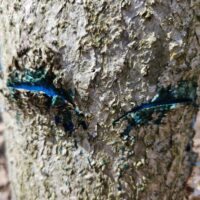
If the tree stems need to come down for safety or other reasons, apply the basal bark or hack and squirt treatments and wait approximately 30 days before cutting down the stem. This should allow time for the herbicide to impact the root system and limit the amount of root sprouting.
Work safely for yourself and the environment by reading and following the herbicide label, wearing the required personal protective gear, and working carefully with cutting tools.
To view this full article and other Purdue Landscape Report articles, please visit Purdue Landscape Report.
Subscribe and receive the newsletter: Purdue Landscape Report Newsletter.
Resources:
ID That Tree: Invasive Tree of Heaven, Purdue Extension – Forestry and Natural Resource (FNR) YouTube Channel
Control & Management — State of Indiana Cooperative Invasives Management (sicim.info)
Invasive Plant Control Database (wisc.edu)
Invasive Species, Playlist, Purdue Extension – FNR YouTube Channel
Report Invasive Species, Purdue Invasive Species
A Woodland Management Moment, Playlist, Purdue Extension – FNR Youtube Channel
Conservation Tree Planting: Steps to Success, Purdue Extension – FNR Youtube Channel
Forest Improvement Handbook, The Education Store
Tree Risk Management – The Education Store, Purdue Extension’s resource center
Investing in Indiana Woodlands, The Education Store
Woodland Invaders, Got Nature? Blog, Purdue Extension – FNR
Indiana Department of Natural Resources: Invasive Species
Invasive Plant Species Identification, Video, Purdue Extension – FNR Youtube Channel
Lenny Farlee, Sustaining Hardwood Extension Specialist
Purdue University Department of Forestry and Natural Resources
Starting in 2019, sassafras trees began wilting and dying in southern Indiana. It was originally thought that laurel wilt, a deadly disease in the southeastern U.S., had made its way to Indiana. However, neither the fungus responsible for causing laurel wilt nor its beetle vector were recovered from wilting trees at the time. A potentially novel fungus was recovered, as well as two i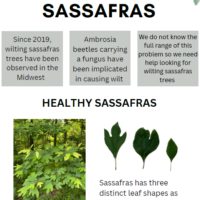 nvasive ambrosia beetle species. Invasive insects, particularly bark and ambrosia beetles are well-known carriers of devastating disease-causing fungi. Dutch elm disease is one of the most famous examples of a beetle-transmitted disease.
nvasive ambrosia beetle species. Invasive insects, particularly bark and ambrosia beetles are well-known carriers of devastating disease-causing fungi. Dutch elm disease is one of the most famous examples of a beetle-transmitted disease.
Sassafras trees are an important understory tree that aids in nutrient cycling and are important food sources for deer and rabbit populations in the winter months. They are also important to native butterfly populations like the Swallowtail butterfly, that uses sassafras as a host. At this time, we do not know what is killing our native sassafras trees or the range of impacted trees. This is a problem because if we do not know what is causing wilt or where trees are wilting, then we cannot work to identify ways to protect our native sassafras trees.
We need more help in identifying locations of wilting sassafras trees. We anticipate trees to start wilting towards the end of the summer, from late July through September. If you see any wilting or dying sassafras trees, please email sassafras.wilt@gmail.com to report it. You can also use the QR code on the bottom of the attached handout.
To learn more see the attached Sassafras Wilt Report Flyer.
Resources:
Report Invasive Species, Purdue Invasive Species
ID That Tree: Sassafras
ID That Tree: Sassafras Spring Bloom Edition
Morton Arboretum: Sassafras
Sassafras, Purdue Fort Wayne Native Trees of Indiana River Walk
ID That Tree Spring Bloom Editions, Got Nature Blog
Hardwood Lumber and Veneer Series: Sassafras, The Education Store
Purdue Arboretum Explorer
The Woody Plant Seed Manual, U.S. Forest Service
Native Trees of the Midwest, The Education Store
Shrubs and Woody Vines of Indiana and the Midwest, The Education Store
Investing in Indiana Woodlands, The Education Store
Forest Improvement Handbook, The Education Store
ID That Tree, Purdue Extension-Forestry & Natural Resources (FNR) YouTube playlist
Woodland Management Moment , Purdue Extension-FNR YouTube playlist
Olivia Bigham, Graduate Student
Purdue Forestry and Natural Resources & Hardwood Tree Improvement & Regeneration Center (HTIRC)
Matt Ginzel, Associate Professor
Purdue Forestry and Natural Resources & Department of Entomology
Purdue Landscape Report: I have lost count of the number of times I’ve witnessed people working with chainsaws in shorts, a tank top, and flip flops with maybe a pair of earbuds, and it makes me cringe every time. According to the CDC, over 36,000 chainsaw-related injuries a year are reported with annual medical costs of more than $350 million (Johnson, 2023). Wearing the proper personal protective equipment (PPE) can help prevent accidents and injuries (Fig. 1). PPE is there to protect you from head to toe and if you are investing in a chainsaw, it doesn’t take much more to invest in the proper PPE. Including a work shirt and pants, if you’re using a chainsaw you should wear protection for your head, eyes and ears, hands, legs, and feet, most of which can be found at your local hardware store or home center.
Protecting your head means using a helmet, not a baseball cap or bandanna. Depending on the type of work you’re doing there is a risk of being struck by wood or branches or if kickback occurs, sending the chainsaw back towards your head. Safety glasses will help keep sawdust and other debris out of your eyes and should be stamped with Z87.1, showing they conform to ANSI safety regulations. Normal glasses and sunglasses are not rated for being struck and can shatter, sending broken lenses into your eyes. Ear protection can be in the form of plugs or muffs and should be rated to reduce noise to appropriate levels when worn properly.
Most modern chainsaws have built-in anti vibration technology to reduce fatigue, but having a nice pair of work gloves will still help to protect your hands and grip. Gloves will help protect against debris and are also good to wear for chainsaw maintenance. Although not about PPE, another note on protecting your hands when operating a chainsaw includes the proper use of the chain brake. Injuries can occur on the right hand because operators will remove it from the back handle to activate the chain brake with the palm of their hand and miss it, putting their hand on the still moving chain. Injuries on either hand can happen when one handing a saw while using your other hand to brace or manage what you are cutting and losing control. The chain brake is designed to be engaged by popping your left wrist forward while maintaining a grip with both hands on the handles.
To protect your legs some form of chaps or chap pants are needed. Prices can range from around $40 for a pair of wrap-chaps that can be worn over your work pants up to around $400 for a high-end pair of chap pants that are a stand-alone work pant replacement. Whichever you choose to wear, the protection should be from the top of your thigh to the top of your foot and wrap around your calf. Care should be taken to keep them clean from gas and oil and if they are ever damaged by a chainsaw, chaps should be discarded and replaced. Once the protective material has been damaged the safety has been compromised. Chainsaw boots are also available to protect your lower legs and feet but are expensive and can be heavy. A sturdy work boot should be worn at the very least while staying alert to how close the chainsaw is coming to you. And please, no open-toed shoes.
Whatever the task, if you are going to do your own chainsaw work, then I implore you to wear your PPE from head to toe. I know it’s hot and can get uncomfortable, but all it takes is one mistake to send you to the ER. If you feel the job is beyond your capabilities you can always contact an ISA certified arborist at Find an Arborist through the treesaregood.org website.
To view this full article and other Purdue Landscape Report articles, please visit Purdue Landscape Report.
Subscribe and receive the newsletter: Purdue Landscape Report Newsletter.
Resources:
The Purdue Landscape Report
A Woodland Management Moment, Playlist, Purdue Extension – Forestry and Natural Resources (FNR) Youtube Channel
Conservation Tree Planting: Steps to Success, Purdue Extension – FNR Youtube Channel
Forest Improvement Handbook, The Education Store
Find an Arborist website, Trees are Good, International Society of Arboriculture (ISA)
Caring for storm-damaged trees/How to Acidify Soil in the Yard – In the Grow, Purdue Extension
Moist soil and rotten roots makes it easy for trees to come crashing down – Fox 59 News
Tree Risk Management – The Education Store, Purdue Extension’s resource center
Mechanical Damage to Trees: Mowing and Maintenance Equipment – The Education Store
Trees and Electric Lines – The Education Store
Tree Support Systems, The Education Store
Corrective Pruning for Deciduous Trees, The Education Store
Tree Installation: Process and Practices, The Education Store
Ben McCallister, Urban Forestry Specialist
Purdue Forestry & Natural Resources
Purdue Landscape Report: Poison hemlock was introduced to North America as a garden/ornamental plant. It is a native of Europe, and it is a member of the Apiaceae (parsley) family.
Purdue experts Bill Johnson and Marcelo Zimmer wrote about poison hemlock in a Purdue Pest & Crop newsletter.
They wrote that poison hemlock can be noticed very early in the spring every year, as it is typically one of the first weeds to green up, usually in late February to early March if temperatures are favorable. They said the largest threat of this weed is the toxicity of its alkaloids if ingested by livestock or humans, but it can also reduce the aesthetic value of landscapes and has been reported to creep into no-till corn and soybean fields as well.
Purdue Extension’s fact sheet on poison hemlock states that it can also be found along roads, streams, trails, ditches, forest edges, and waste areas.
The Purdue experts said that poison hemlock is a biennial weed that exists as a low-growing herb in the first year, and bolts to three to eight feet tall in the second year, when it produces flowers and seed. It is often not noticed until the bolting and reproductive stages of the second year. Poison hemlock is often confused with wild carrot, but can be distinguished by its lack of hairs and purple blotches that occur on the stems.
The experts pointed out that poison hemlock contains five alkaloids that are toxic to humans and livestock, and it can be lethal if ingested. They warn that the plant’s alkaloids may also be absorbed through the skin, so if you find yourself hand-pulling poison hemlock, it would be a good idea to wear gloves. All parts of the plants contain the toxic alkaloids with levels being variable throughout the year. Symptoms of toxicity include nervousness, trembling, and loss of coordination followed by depression, coma, and/or death. Initial symptoms will occur within a few hours of ingestion.
For history buffs, the Greek philosopher Socrates was sentenced to death by hemlock poisoning.
Cases of poisoning due to poison hemlock ingestion are rare as the plants emit a mousy odor that makes it undesirable and unpalatable to livestock and humans. Consumption and toxicity in animals usually occur in poorly managed or overgrazed pastures where animals are forced to graze poison hemlock because desirable forage is lacking.
To view this full article and other Purdue Landscape Report articles, please visit Purdue Landscape Report.
Subscribe and receive the newsletter: Purdue Landscape Report Newsletter.
Resources:
The Purdue Landscape Report
Purdue Pest & Crop Newsletter
Invasive Plant Species Fact Sheets: Poison Hemlock, The Education Store, Purdue Extension Resource Center
Poison Hemlock (Conium maculatum), United States Department of Agriculture (USDA)
Invasive plants: impact on environment and people, The Education Store, Purdue Extension’s resource center
Woodland Management Moment: Invasive Species Control Process, Video, Purdue Extension – Forestry and Natural Resources (FNR) YouTube Channel
Invasive Species, Playlist, Purdue Extension – FNR YouTube Channel
What are invasive species and why should I care?, Got Nature? Blog, Purdue Extension – FNR
Report Invasive, Purdue College of Agriculture – Entomology
John Woodmansee, Extension Educator, Whitely County
Purdue Extension
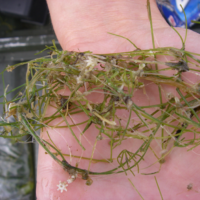 MyDNR, Indiana’s Outdoor Newsletter: Did you know that Indiana’s waterways can be altered by the presence of aquatic invasive species? Non-native plants, animals, and organisms can disrupt bodies of water and ecosystems, threatening sport fisheries and other commercial resources.
MyDNR, Indiana’s Outdoor Newsletter: Did you know that Indiana’s waterways can be altered by the presence of aquatic invasive species? Non-native plants, animals, and organisms can disrupt bodies of water and ecosystems, threatening sport fisheries and other commercial resources.
If you’re wondering what you can do to help prevent the spread of aquatic invasive species, there are many easy steps that Hoosiers and out-of-state visitors can take to stop aquatic hitchhikers:
- Clean off any animals, plants, and mud from any angling or boating gear.
- Drain the water from watercrafts, bladder tanks, bilges, motors, livewells, and portable bait containers before leaving the water access area.
- Make sure everything air-dries for five days or longer or is dried with a towel.
- Dispose of any unwanted or unused bait, fish parts, and packing materials in the trash, rather than on the ground or in water. Remember, littering harms the environment.
DNR is counting on you to help protect Indiana’s waterways and species.
Newsletter can be found online: MyDNR Email Newsletter
For more information please visit DNR: Fish & Wildlife: Aquatic Invasive Species (AIS).
Resources:
Invasive Mussels, IN DNR Fish and Wildlife
Aquatic Invasive Species in the Great Lakes: The Quagga Mussel, Purdue Extension – Forestry & Natural Resources (FNR) Got Nature? Blog
Aquatic Invaders in the Marketplace, Illinois-Indiana Sea Grant (IISG)
Invasive Species, Playlist, Purdue Extension – FNR YouTube Channel
What are invasive species and why should I care?, Got Nature? Blog, Purdue Extension – Forestry and Natural Resources
Report Invasive Species, Purdue Invasive Species
The GLEDN Phone App – Great Lakes Early Detection Network
EDDMaps – Early Detection and Distribution Mapping System
Indiana Department of Natural Resources: Invasive Species
Indiana Invasive Species Council
Cooperative Invasive Species Management Area (CISMA)
Great Lakes Sea Grant Network (GLERL), NOAA – Great Lakes Environmental Research Laboratory
A Field Guide to Fish Invaders of the Great Lake Regions, Illinois-Indiana Sea Grant (IISG)
Purdue Researchers Get to the Bottom of Another Quagga Mussel Impact, Illinois-Indiana Sea Grant (IISG)
Invasive plants: Impact on Environment and People, The Education Store, Purdue Extension’s resource center
Protect Your Waters, U.S. Fish and Wildlife Service & U.S. Coast Guard
Nongame and Endangered Wildlife, Indiana Department of Natural Resources
Indiana Department of Natural Resources, Department of Fish & Wildlife
Watering your trees has become an essential activity. With only a few storms so far this summer, much of the state has abnormally dry to severe drought conditions. View U.S. Drought Monitor to see diagram for Indiana. Many homeowners are finding their trees with dry and wilted leaves. In this video, Lindsey Purcell, Indiana Arborist Association executive director, talks about the importance of watering your trees and how to do so effectively.
Extreme heat can have a major impact on tree health and survival. Water is the most limiting ecological resource for a tree, and without adequate moisture, decline and death are imminent. It reduces carbohydrate production, significantly lowering energy reserves and production of defense chemicals in the tree. Check out this publication titled Drought? Don’t Forget the Trees! to learn what to look for for any weakening issues including pests that like the dry conditions.
If you have any questions regarding wildlife, trees, forest management, wood products, natural resource planning or other natural resource topics, feel free to contact us by using our Ask an Expert web page.
Resources:
Summer Tree Care, Purdue Landscape Report
Drought? Don’t Forget the Trees!, The Education Store, Purdue Extension resource center
Extreme Heat, Purdue Extension – IN-PREPared
Drought Information, Indiana Department of Natural Resources
Planting Your Tree Part 1: Choosing Your Tree, Purdue Extension YouTube Channel
Tree Selection for the “Un-natural” Environment, The Education Store
Tree Pruning Essentials Video, Purdue Extension YouTube Channel
Tree Defect Identification, The Education Store
Tree Wound and Healing, Got Nature? Blog, Purdue Extension – Forestry and Natural Resources
Surface Root Syndrome, The Education Store
Submit Sample, Purdue Plant & Pest Diagnostic Lab
Find an Arborist, Indiana Arborist Association
Ben McCallister, Urban Forestry Specialist
Purdue Forestry & Natural Resources
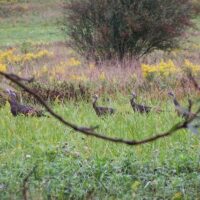 MyDNR, Indiana’s Outdoor Newsletter: DNR is counting on you to participate in their Turkey Brood Count this summer. Now that turkey chicks (poults) have hatched in Indiana, DNR needs your help counting turkey broods (hens with poults) and hens without poults. Brood reports have been collected since 1993 to calculate the annual Wild Turkey Production Index, which is used to inform biologists about population status and guide wildlife management for the species.
MyDNR, Indiana’s Outdoor Newsletter: DNR is counting on you to participate in their Turkey Brood Count this summer. Now that turkey chicks (poults) have hatched in Indiana, DNR needs your help counting turkey broods (hens with poults) and hens without poults. Brood reports have been collected since 1993 to calculate the annual Wild Turkey Production Index, which is used to inform biologists about population status and guide wildlife management for the species.
In 2022, DNR received more than 3,200 reports across all 92 counties in Indiana, and we’re hoping for even more this year. Our goal is to receive 3,000 total observations with at least 25 per county.
Share your 2023 observations with us online from now until Aug. 31. Recording observations takes less than five minutes, and no password is required.
We appreciate your reports!
Newsletter can be found online: MyDNR Email Newsletter
For more information please visit DNR: Fish & Wildlife: Turkey Brood Reporting.
Resources:
Four Simple Steps, Help Indiana DNR Estimate Wild Turkey Populations, Purdue Extension – Forestry & Natural Resources
Truths and Myths about Wild Turkey, The Education Store, Purdue Extension resource center
Wildlife, Playlist, Purdue Extension – Forestry and Natural Resources YouTube Channel
Forest Improvement Handbook, The Education Store
Help With Wild Turkey Populations, Video, Purdue Extension – Forestry and Natural Resources YouTube Channel
Turkey Brood Reporting, Indiana Department of Natural Resources (IDNR)
Wild Turkey, Indiana Department of Natural Resources (IDNR)
Wild Turkey Hunting Biology and Management, Indian Department of Natural Resources (IDNR)
Subscribe to Purdue Extension-Forestry & Natural Resources YouTube Channel, Wildlife Playlist
Indiana Department of Natural Resources, Department of Fish & Wildlife
MyDNR, Indiana’s Outdoor Newsletter: Blotchy bass syndrome (BBS) is the occurrence of black ink-like spots (hyperpigmentation) on the skin, fins, and/or mouths of freshwater bass species.
Researchers once thought that melanosis was caused by sun exposure or stress related to fishing, temperature, or pollution; however, researchers recently discovered that a family of viruses was associated with the black spots in fish that were in poor body condition.
The Division of Fish & Wildlife is partnering with the United States Geological Survey (USGS) to collect samples from black bass species to test for BBS and needs your help. DNR encourages anglers to report observations of affected bass when you are fishing, so they and USGS can learn more about the effect of this family of viruses.
How to participate:
- Download the MyCatch app from Angler’s Atlas.
- Register for the “Blotchy Bass Bonanza.”
- Take photos of all the bass you’ve caught (preferably on a measuring board) while fishing and upload them to the MyCatch app.
The Blotchy Bass Bonanza runs from March 1, 2023 —Feb. 29, 2024. The Indiana DNR is not associated with the MyCatch app or the Blotchy Bass Bonanza.
Newsletter can be found online: MyDNR Email Newsletter
For more information please visit Investigating blotch bass syndrome in black basses.
Resources:
FNR Extension Aquaculture and Aquatic Resources
FNR Extension Publications
Indiana Pond Fish, Species Identification Card Set, Purdue Extension – Forestry and Natural Resources (FNR)
Walleye Farmed Fish Fact Sheet, The Education Store, Purdue Extension’s resource center
Pacific White Shrimp Farmed Fact Sheet, The Education Store
Yellow Perch Farmed Fish Fact Sheet, The Education Store
Tilapia Farmed Fish Fact Sheet, The Education Store
Rainbow Trout Farmed Fish Fact Sheet, The Education Store
American Paddlefish, The Education Store
A Guide to Small-Scale Fish Processing Using Local Kitchen Facilities, The Education Store
Aquaculture Family Coloring Book Development, The Education Store
Eat Midwest Fish, Illinois-Indiana Sea Grant online resource hub
Aquatics & Fisheries Videos, Purdue Extension-Forestry and Natural Resources YouTube Channel Playlist
Indiana Department of Natural Resources, Department of Fish & Wildlife
Purdue Landscape Report: The hemlock woolly adelgid (Adelges tsugae) continues its eastward spread across the US. In 2022, seven new counties were added to the distribution map of this invasive insect. While it is not present in Indiana yet, it is confirmed throughout the eastern USA from northern Georgia to Maine, extending west into Michigan, Ohio, and Kentucky.
Since its introduction in the 1950s, hemlock woolly adelgid has caused severe mortality of eastern hemlock in the United States. Not only is this a significant impact on our native tree diversity, hemlock losses are linked to a decline in several native bird species in the New England and mid-Atlantic forests (Ellison et al. 2018). In Indiana, eastern hemlock has a scattered native range in isolated locations of the west-central and southern regions of the state. It typically grows on steep slopes, canyons, and ravines. Hemlock woolly adelgid is also a threat to ornamental hemlocks, which are frequently used in landscaping.
Identifying Eastern Hemlock
Hemlock woolly adelgid will only feed on hemlocks, so proper tree identification is crucial. If you’re not sure whether your conifer is hemlock, check the color, shape, and arrangement of the needles. The needles of eastern hemlock grow singly (not in clusters) in alternate or opposite positions. The needles are flattened, and have two white stripes on the underside. The cones are small (1-2 cm), and when dry, they can resemble a rosette.
Monitoring for Hemlock Woolly Adelgid
The white “wool” balls are the most tell-tale sign of this pest. Check the undersides of the branches at the base of the needles, and look for small, round, white cottony masses that cover the twig. These are actually the egg sacs of the hemlock woolly adelgid. You may also notice the “crawlers”, or the mobile nymphs, which are tiny, oval-shaped, reddish-brown insects.
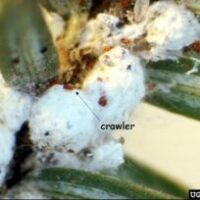
Photo of egg sacs of the hemlock woolly adelgid. These white “wool” balls are the most tell-tale sign of this pest.
If you frequently check hemlock trees, you may see other white spots that resemble the woolly adelgid. The cocoons of elongate hemlock scale are often confused with hemlock woolly adelgid. However, note how the white “spots” from the scale infestation are flattened and cover the needles. Hemlock wooly adelgids congregate at the base of the needles along the twig, not on the needles themselves, and the egg sacs are round in shape. Single, large egg sacs found throughout the branch are often spider egg sacs or oak skeletonizer cocoons.
Report any suspected findings of hemlock woolly adelgid at the Eearly Detection Distribution Map System (EDDMapS) website.
To view this original article and other Purdue Landscape Report articles, please visit Purdue Landscape Report.
Resources:
ID That Tree: Eastern Hemlock, video, Purdue Extension – Forestry and Natural Resources (FNR) YouTube Channel
Distinguishing Hemlock From Yew, The Purdue Landscape Report
Normal Needle Drop: Even Healthy Evergreens are not Evergreen, Purdue Plant & Pest Diagnostic Lab (PPDL)
Phomopsis Dieback of Spruce, The Education Store, Purdue Extension resource center
Chlorosis of Pine Trees, The Purdue Landscape Report
Borers of Pines and Other Needle Bearing Evergreens in Landscapes, The Education Store
Stress-related Conifer Dieback, The Education Store
Certified Soil Testing Laboratories, Purdue Extension-Master Gardener Program
Tree Installation: Process and Practices, The Education Store
Planting Forest Trees and Shrubs in Indiana, The Education Store
Planting Your Tree Part 1: Choosing Your Tree, video, Purdue Extension – FNR YouTube Channel
Tree Defect Identification, The Education Store
Tree wounds and healing, Got Nature? Blog
Shrubs and Woody Vines of Indiana and the Midwest, The Education Store
Tree Risk Management, The Education Store
Why Is My Tree Dying?, The Education Store
Consumer Horticulture: Collecting Soil Samples for Testing, The Education Store
Find an Arborist website, Trees are Good, International Society of Arboriculture (ISA)
Alicia Kelley, Cooperative Agricultural Pest Survey (CAPS) Coordinator
Purdue Extension – Entomology
Purdue Landscape Report: Each spring the PPDL receives several samples of oak trees showing curled, twisted, stunted and/or generally ratty looking leaves. When there are holes in the leaves or leaf edges are missing tissue, we add another symptom name to the mix: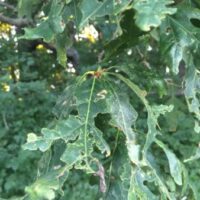 tatters.
tatters.
Distorted new growth and tatters are most common on white oaks and may occasionally show up on red oak, hackberry and other trees. Upon initial inspection the leaves look as if they have been shredded or severely fed upon by insects. However, a closer observation of the leaves will reveal that the leaf tissue has not been removed, but rather, it never developed normally. We have seen this problem on white oaks for many years in Indiana and it has been reported in other states throughout the Midwest.
Several possible causes for this symptom have been proposed, including poor growing conditions, insect injury, leaf diseases, late spring frost damage and herbicide drift; however, no single factor serves to explain all the cases. In 2020 we saw a distinct link between tattered oak leaves and a late spring frost that year but the connection is not always so clear cut. See PLR article: Oaks Will Persist After Ugly Summer Start.
Researchers have shown that acetochlor and s-metolachlor drift can cause tatters-like symptoms but results were variable, and in some treatments red oaks were more affected than white oaks, contrary to the expected results. In many instances there is no direct link to herbicide drift. We once had samples from a white oak tree that showed symptoms of tatters and leaf curl every year, yet was located in the middle of a heavily forested area miles away from any agricultural fields that might have been a source of herbicide drift. While the exact cause may not be clear, it does appear that conditions that lead to tatters occur while the leaves are still developing.
To view this full article and other Purdue Landscape Report articles, please visit Purdue Landscape Report.
Subscribe and receive the newsletter: Purdue Landscape Report Newsletter.
Resources:
The Purdue Landscape Report
Certified Soil Testing Laboratories, Purdue Extension-Master Gardener Program
Consumer Horticulture: Collecting Soil Samples for Testing, The Education Store
Purdue Landscape Report Facebook Page
Find an Arborist website, Trees are Good, International Society of Arboriculture (ISA)
Tree Installation: Process and Practices, The Education Store
Planting Forest Trees and Shrubs in Indiana, The Education Store
Planting Your Tree Part 1: Choosing Your Tree, Video, Purdue Extension – Forestry and Natural Resources YouTube Channel
Tree Defect Identification, The Education Store, Purdue Extension resource center
Tree wounds and healing, Got Nature? Blog
Tree Pruning Essentials, Publication & Video, The Education Store
Shrubs and Woody Vines of Indiana and the Midwest, The Education Store
Tree Risk Management, The Education Store
Why Is My Tree Dying?, The Education Store
Tom Creswell, Plant & Pest Diagnostic Laboratory Director
Purdue Botany and Plant Pathology
Recent Posts
- Report Spotted Lanternfly – Purdue Landscape Report
Posted: April 10, 2024 in Alert, Forestry, Invasive Insects, Plants, Wildlife, Woodlands - Declining Pines of the White Variety – Purdue Landscape Report
Posted: in Alert, Disease, Forestry, Plants, Wildlife, Woodlands - Are you seeing nests of our state endangered swan? – Wild Bulletin
Posted: April 9, 2024 in Alert, Forestry, How To, Wildlife - 2024-25 Fishing Guide now available – Wild Bulletin
Posted: April 4, 2024 in Alert, Aquaculture/Fish, Aquatic/Aquaculture Resources, How To, Ponds, Wildlife - Look Out for Invasive Carp in Your Bait Bucket – Wild Bulletin
Posted: March 31, 2024 in Alert, Aquaculture/Fish, Aquatic/Aquaculture Resources, Invasive Animal Species, Wildlife - Rare Cicada Emergence: Q&A with Purdue Bug Expert
Posted: March 25, 2024 in Alert, Forestry, Plants, Safety, Wildlife - State of Indiana Proclamation-Invasive Species Week 2024
Posted: February 19, 2024 in Alert, Forestry, Forests and Street Trees, Invasive Animal Species, Invasive Insects, Invasive Plant Species, Urban Forestry, Wildlife, Woodlands - Report Your Mudpuppy Observations to Indiana DNR – Wild Bulletin
Posted: February 1, 2024 in Alert, Aquaculture/Fish, Aquatic/Aquaculture Resources, How To, Wildlife - Learn About Lead: Avoiding Lead Ingestion in Wild Game, Wild Bulletin
Posted: December 8, 2023 in Alert, Disease, How To, Safety, Wildlife - Invasive Carp Removal on the Ohio River, Wild Bulletin
Posted: in Alert, Aquaculture/Fish, Aquatic/Aquaculture Resources, Invasive Animal Species, Wildlife
Archives
Categories
- Alert
- Aquaculture/Fish
- Aquatic/Aquaculture Resources
- Ask the Expert
- Christmas Trees
- Community Development
- Disease
- Drought
- Forestry
- Forests and Street Trees
- Gardening
- Got Nature for Kids
- Great Lakes
- How To
- Invasive Animal Species
- Invasive Insects
- Invasive Plant Species
- Land Use
- Natural Resource Planning
- Nature of Teaching
- Plants
- Podcasts
- Ponds
- Publication
- Safety
- Timber Marketing
- Uncategorized
- Urban Forestry
- Webinar
- Wildlife
- Wood Products/Manufacturing
- Woodland Management Moment
- Woodlands
